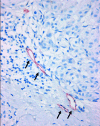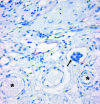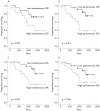Tumour lymphangiogenesis is a possible predictor of sentinel lymph node status in cutaneous melanoma: a case-control study
- PMID: 16443733
- PMCID: PMC1860322
- DOI: 10.1136/jcp.2005.028431
Tumour lymphangiogenesis is a possible predictor of sentinel lymph node status in cutaneous melanoma: a case-control study
Abstract
Background: Cutaneous melanoma spreads preferentially through the lymphatic route and sentinel lymph node (SLN) status is regarded as the most important predictor of survival.
Aims: To evaluate whether tumour lymphangiogenesis and the expression of vascular endothelial growth factor C (VEGF-C) is related to the risk of SLN metastasis and to clinical outcome in a case-control series of patients with melanoma.
Methods: Forty five invasive melanoma specimens (15 cases and 30 matched controls) were investigated by immunostaining for the lymphatic endothelial marker D2-40 and for VEGF-C. Lymphangiogenesis was measured using computer assisted morphometric analysis.
Results: Peritumorous lymphatic vessels were more numerous, had larger average size, and greater relative area than intratumorous lymphatics. The number and area of peritumorous and intratumorous lymphatics was significantly higher in melanomas associated with SLN metastasis than in non-metastatic melanomas. No significant difference in VEGF-C expression by neoplastic cells was shown between metastatic and non-metastatic melanomas. Using logistic regression analysis, intratumorous lymphatic vessel (LV) area was the most significant predictor of SLN metastasis (p = 0.04). Using multivariate analysis, peritumorous LV density was an independent variable affecting overall survival, whereas the intratumorous LV area approached significance (p = 0.07).
Conclusions: This study provides evidence that the presence of high peritumorous and intratumorous lymphatic microvessel density is associated with SLN metastasis and shorter survival. The intratumorous lymphatic vessel area is the most significant factor predicting SLN metastasis. The tumour associated lymphatic network constitutes a potential criterion in the selection of high risk patients for complementary treatment and a new target for antimelanoma therapeutic strategies.
References
-
- Rigel D S. Malignant melanoma: perspectives on incidence and its effects on awareness, diagnosis, and treatment. CA Cancer J Clin 199646195–198. - PubMed
-
- WHO WHO declares lymphatic mapping to be the standard of care for melanoma. Oncology 199913288
Publication types
MeSH terms
Substances
Grants and funding
LinkOut - more resources
Full Text Sources
Other Literature Sources
Medical








